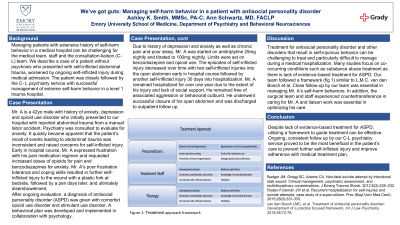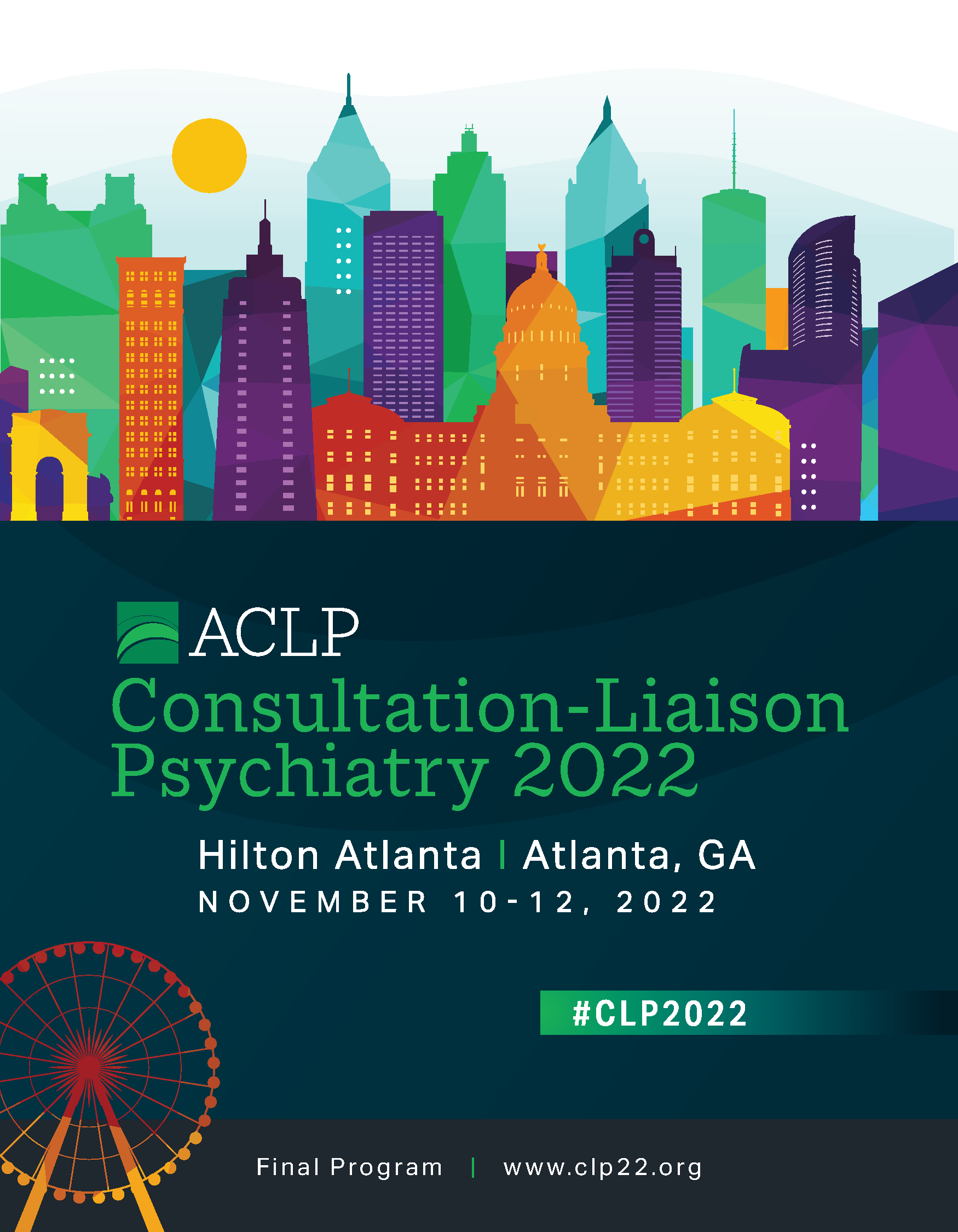Back

Suicidality
Poster Session
(173) We’ve got guts: Managing self-harm behavior in a patient with antisocial personality disorder

Abstract:
Background: Managing patients with extensive history of self-harm behavior in a medical hospital can be challenging for the medical team, staff and the consultation-liaison (C-L) team. We describe a case of a patient without psychosis who presented with self-inflicted abdominal trauma, worsened by ongoing self-inflicted injury during medical admission. The patient was closely followed by the C-L psychiatry service with successful management of extreme self-harm behavior in a level 1 trauma hospital.
Case: Mr. A is a 42yo male with history of anxiety, depression and opioid use disorder who initially presented to our hospital with reported abdominal trauma from a manual labor accident. Psychiatry was consulted to evaluate for anxiety. It quickly became apparent that the patient’s recall of events leading to abdominal trauma was inconsistent and raised concerns for self-inflicted injury. Early in hospital course, Mr. A expressed frustration with his pain medication regimen and requested increased doses of opioids and benzodiazepines for anxiety. Mr. A’s poor frustration tolerance and coping skills resulted in further self-inflicted injury to the wound with a plastic fork at bedside, followed by a pen days later, and ultimately disembowelment.
After ongoing evaluation, a diagnosis of antisocial personality disorder was suspected, and a behavioral plan was developed and implemented in collaboration with psychology. Due to history of depression and anxiety as well as chronic pain and poor sleep, Mr. A was started on amitriptyline 25mg nightly and titrated to 100mg nightly. Limits were set on benzodiazepine and opioid use. The episodes of self-harm behavior decreased over time with two self-inflicted injuries into the open abdomen early in hospital course followed by another self-inflicted injury 30 days into hospitalization. Mr. A remained hospitalized for several months due to the extent of his injury, but remained free of associated aggression or behavioral outburst and was discharged to outpatient follow up.
Discussion: Treatment for antisocial personality disorder and other disorders that result in self-harm behavior can be challenging to treat and particularly difficult to manage during a medical hospitalization. Close follow-up by our team was essential in managing Mr. A’s self-harm behaviors. In addition, the surgical team and staff experienced countertransference in caring for Mr. A and liaison work was essential in optimizing his care.
Conclusion: Ongoing, consistent follow up by our C-L psychiatry service proved to be the most beneficial in the patient’s care to prevent further self-inflicted injury and improve adherence with medical treatment plan.
References:
Badger JM, Gregg SC, Adams CA. Non-fatal suicide attempt by intentional stab wound: Clinical management, psychiatric assessment, and multidisciplinary considerations. J Emerg Trauma Shock. 2012;5(3):228–232.
Roden-Foreman JW et al. Recurrent hospitalization for self-injuries and suicide attempts: case study of a super-utilizer. Proc (Bayl Univ Med Cent). 2015;28(3):331-333.
Background: Managing patients with extensive history of self-harm behavior in a medical hospital can be challenging for the medical team, staff and the consultation-liaison (C-L) team. We describe a case of a patient without psychosis who presented with self-inflicted abdominal trauma, worsened by ongoing self-inflicted injury during medical admission. The patient was closely followed by the C-L psychiatry service with successful management of extreme self-harm behavior in a level 1 trauma hospital.
Case: Mr. A is a 42yo male with history of anxiety, depression and opioid use disorder who initially presented to our hospital with reported abdominal trauma from a manual labor accident. Psychiatry was consulted to evaluate for anxiety. It quickly became apparent that the patient’s recall of events leading to abdominal trauma was inconsistent and raised concerns for self-inflicted injury. Early in hospital course, Mr. A expressed frustration with his pain medication regimen and requested increased doses of opioids and benzodiazepines for anxiety. Mr. A’s poor frustration tolerance and coping skills resulted in further self-inflicted injury to the wound with a plastic fork at bedside, followed by a pen days later, and ultimately disembowelment.
After ongoing evaluation, a diagnosis of antisocial personality disorder was suspected, and a behavioral plan was developed and implemented in collaboration with psychology. Due to history of depression and anxiety as well as chronic pain and poor sleep, Mr. A was started on amitriptyline 25mg nightly and titrated to 100mg nightly. Limits were set on benzodiazepine and opioid use. The episodes of self-harm behavior decreased over time with two self-inflicted injuries into the open abdomen early in hospital course followed by another self-inflicted injury 30 days into hospitalization. Mr. A remained hospitalized for several months due to the extent of his injury, but remained free of associated aggression or behavioral outburst and was discharged to outpatient follow up.
Discussion: Treatment for antisocial personality disorder and other disorders that result in self-harm behavior can be challenging to treat and particularly difficult to manage during a medical hospitalization. Close follow-up by our team was essential in managing Mr. A’s self-harm behaviors. In addition, the surgical team and staff experienced countertransference in caring for Mr. A and liaison work was essential in optimizing his care.
Conclusion: Ongoing, consistent follow up by our C-L psychiatry service proved to be the most beneficial in the patient’s care to prevent further self-inflicted injury and improve adherence with medical treatment plan.
References:
Badger JM, Gregg SC, Adams CA. Non-fatal suicide attempt by intentional stab wound: Clinical management, psychiatric assessment, and multidisciplinary considerations. J Emerg Trauma Shock. 2012;5(3):228–232.
Roden-Foreman JW et al. Recurrent hospitalization for self-injuries and suicide attempts: case study of a super-utilizer. Proc (Bayl Univ Med Cent). 2015;28(3):331-333.
.jpg)
Ashley K. Smith, MMSc PA-C
Physican Assistant
Emory University
Atlanta, Georgia, United States

